Emlen Etting 1963 mid-century mod Abstract Expressionist painting Philadelphia
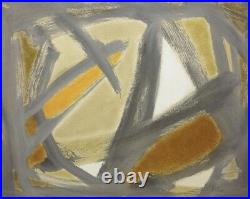
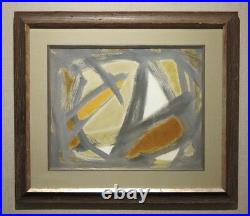
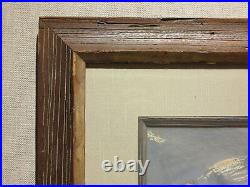
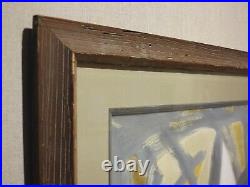
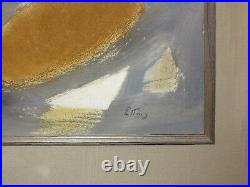
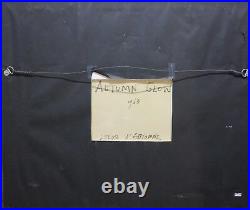

Mixed media on artist board, 16 x 20 inches; 26 x 30 inches in mid-century chestnut frame of the period. Emlen Etting was a painter, sculptor, filmmaker, and member of Philadelphias elite Main Line Society.
He attended schools in Lausanne, Switzerland, and St. Georges in Newport, Rhode Island.
After graduating from Harvard in 1928, he studied with the artist Andre Lhote in Paris. During World War II, Etting served in the psychological warfare division of the Office of War Information. He was present at the liberation of Paris and he collaborated with Orson Welles to record the event.
Was born to Florence Lucas Etting and Emlen Pope Etting Sr. A failed stockbroker, in 1905. Both Emlens mother and aunt were proud members of Philadelphias Main Line society.
An earlier son was born to the Ettings on August 15, 1903, and given the name Emlen Pope Etting Jr. The child died just three days prior to his first birthday, on August 18, 1904. The following August 24, 1905, Florence gave birth to her second son and, once again, gave him the name of Emlen Pope Etting Jr. Young Emlens father died of a heart attack when the baby was only two months old, on October 23, 1905.
Florence Etting died on April 13, 1951. Both his parents and the first Emlen Jr. Are buried in West Laurel Hill Cemetery in Bala Cynwyd, Pennsylvania.
Emlen was reared in a European fashion as much as he was American. Emlen lived with his mother in Europe for much of his childhood. Emlens Aunt Harriet wanted to ensure Emlen grew to be the Philadelphia gentleman he was meant to be and enrolled him in St. Georges School from 1920 to 1924.
Georges, an Episcopal boarding school, was considered at that time to be one of only two suitable options for a young man from Philadelphias upper crust. Emlen studied French at Harvard University. After graduating, he traveled to Europe to study art. It was a lifestyle underwritten by his aunt, Harriet Etting Brown. He traveled to Munich but was drawn to life in Paris and into the tutelage of the artist Andre Lhote.
Lhote taught his students to reduce their subjects into lines and shapes. Emlen remained influenced by Lhote, his teacher and mentor, for the rest of his life. Paris at that time was a students world. It was filled with myriad forms of art, philosophy, and all the passionate discussions that could accompany it. He frequented the most exclusive art shows and enjoyed the avant-garde films screened in Paris Studio 28.
It was in this artistic crucible that Emlen mingled with the most influential artists of the day. In an interview with Marina Pacini from 1988, Emlen describes his experience studying under Lhote in Paris: No, it was fluid.People came and went in the classes. You know, sometimes people came and somebody would be very annoyed at something he destroyed, something theyd done on a canvas, and they were horrified and would never come back. It was in America, I was fascinated when I came back.
It was done more like, to please the student; youd say something was good and never touch it. But Lhote would barge right in and the students, the whole class, would follow round behind, and he would take one easel, one painting at a time, and whatever he was emphasizing that day, he would rub it in, and how!
Much to the, sometimes, students annoyance. The reason Im telling you this is to explain why it was so fluid. There was no point in having a method of teaching composition one day, and one day color was that you got different people and you didnt follow through with it. And with his method you eventually got all the different facets if you stayed long enough. Etting made several short films. As the name suggests the film attempts to use the cadence and narrative of the poem. From his interview with Marina Pacini: Dali was doing one, two in fact, and Cocteau did Blood of a Poet. And I thought, how interesting it would be if we used the film in a different method. So far it had been used like a novel to tell a story, or else as a documentary and there was nothing else in between, and I wanted to use the film as a poetic medium, to do a poem like T. Eliots poems, and do it entirely visually and thats how I came about to do my film I called Poem 8 and as far as I know it was the first film that experimented in that as a poetic medium. Etting uses very literal images of women, modes of travel, and his own body parts. Etting shows the filmmaker as a present protagonist.Kaletta, PhD, author of a biography on Etting titled. With the Rich and Mighty.
And Ettings other early experimental film. Are technologically unsophisticated, sometimes overly arty and labored, but illustrate Ettings visionary insight into the promise of artistic expression as well as the potential of communication in cinema beyond filming linear plots.
Etting made his mark in early film but as times changed, and he stopped working with the medium. From Etting's interview with Pacini. Well, the films became so much more exciting that my little experiments were pitiful compared to the films of now, its all out.
It isnt that they do poems yet, but they do the experimentation that has brought the most fantastic results. I think it is the great art of today. He was present at the liberation of Paris and made many sketches of the event that were featured in periodicals of the time. His duty was to disseminate the news of the progress of the D-Day invasion and, more importantly, to reassure the devastated villagers he encountered that they could rely on the assistance of US forces in rebuilding their war-torn lives. He wrote, presented, and recorded a series of daily news programs for the American Broadcasting Station in Europe in the towns he visited to accomplish this.
Etting's responsibilities included recording the experiences of the newly liberated French townspeople he met in the wake of the military sweep of their occupied country for the US Army and reporting on what he observed in the field. Etting pieced together and recorded this oral history.
Upon his return home, he published. A "true" story, about his experiences. He felt it was his duty to make a record of the moment, separating the fact from the fiction of war. However, he wanted, nor needed, any war souvenirs of the misery he saw: he never forget what he saw. He felt ashamed that there was such an outpouring of gratitude for him and his party when the appreciation, in his opinion, should be offered instead to the men who fought and died there.
Etting was subsequently attached to the Second French Armored Division. Etting documented these historical events in. A recording collaboration with the legendary Orson Welles. The 12-inch, 78 rpm, Asch 3 record English and French language set recorded the live speeches of Generals Dwight D.
Eisenhower and Charles de Gaulle on August 25, 1944, accompanied by the commentary of Welles and the translation and commentary of Etting. In addition to recording this experience professionally for broadcast and publication, on the day of the liberation of Paris, Etting also made a personal journey into the past, and perhaps, into his aesthetic and artistic process. The painter wrote in his journal that once the Allies had secured the city and he had fulfilled his military obligations, including requisitioning a jeep to confirm the welfare of Pablo Picasso, Etting made his way to Lhote's studio on the Rue lOdessa.Etting was aware that as a Jew, Lhote had had to move from place to place, sleeping where and when he could in fear of the Gestapo, and Etting wondered whether his old teacher had survived the Nazis' four-year occupation of the city. When Etting arrived again at the Rue lOdessa, Lhote was there and seemed unchanged.
Lhote was agitated of course, all of Paris was frenzied, but an excruciating suspicion also plagued Lhote. He begged Etting to assist him. Lhote had to know whether the Luftwaffe had damaged the priceless Delacroix murals in the Palais du Luxembourg, which the Nazis had seized and occupied during the war, and evacuated in the preceding days. After returning from World War II Etting immediately worked as an illustrator, but continued to paint and sculpt. He created a large catalogue of paintings and drawings and worked most every day, believing that an artist should work whether they felt the call of the muse or not.Etting taught at the Philadelphia Museum of Art, the Philadelphia College of Art, Temple Universitys Tyler School of Art, and Florida Southern College. Etting married Gloria Braggiotti in 1938. Gloria was a fixture of Main Line society in her own right. She was a great cook and hostess who can be credited to elevating the modern salon to its highest expression.
Was installed in the plaza next to Philadelphias City Hall in 1982. The sculpture symbolized Philadelphias rise from urban decay. Emlen Etting died of Parkinson's disease on July 20, 1993, at his home in Philadelphia at the age of 88. The item "Emlen Etting 1963 mid-century mod Abstract Expressionist painting Philadelphia" is in sale since Sunday, April 7, 2019.
This item is in the category "Art\Paintings". The seller is "citypictures" and is located in Hudson, New York. This item can be shipped worldwide.
- Subject: abstract
- Date of Creation: 1950-1969
- Listed By: Dealer or Reseller
- Size: Medium (up to 36in.
)
- Region of Origin: US
- Color: Orange
- Medium: mixed media
- Originality: Original
- Style: Abstract
- Width (Inches): 20
- Height (Inches): 16
- Painting Surface: Paper
- Features: Framed
- Quantity Type: Single-Piece Work
- Year: 1963
